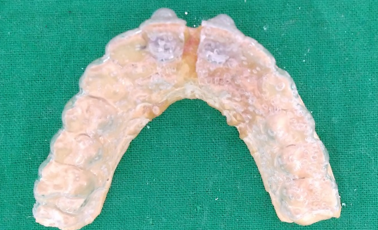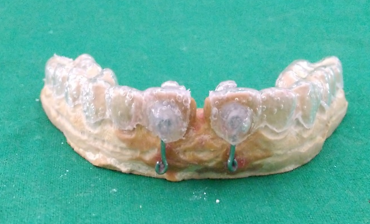- Visibility 98 Views
- Downloads 14 Downloads
- DOI 10.18231/j.idjsr.2021.010
-
CrossMark
- Citation
DM (Diastema Mender) An appliance to close midline spacing
- Author Details:
-
Rahul Goud Padala *
-
Thirumal Naik M
-
E Seena Naik
-
Santosh Reddy B
-
E Srikanth
Introduction
Orthodontics, a subject dealing with the alignment of teeth, correcting several types of malalignments and improving facial aesthetics & smiles is also cursed with a major factor which is termed as “Relapse”.[1], [2] Cases involving the midline diastema have the poorest prognosis with high tendency for relapse, factors being multifactorial.[3], [4] In most cases post-orthodontic relapse of midline diastema is seen due to breakage of the permanent retainer wire as the maintenance of this permanent retainer requires patient compliance and is also multifactorial.[5], [6], [7], [8], [9] In such cases, several mechanics, techniques, and innovative appliances have been given in the literature to manage these relapse conditions.[2], [10], [11], [12], [13] In this report, a case of 31 year old female patient came with debonded lingual retainer and with a relapsed diastema of about 2 mm. As the patient was not interested to undergo orthodontic treatment again, a customized appliance was designed and fabricated using Essix sheet.
Procedure
The maxillary arch impression was recorded and stone cast is poured. Small lengths of 0.7mm stainless steel wire were bent in the shape of small hooks and each one is stabilized on the palatal aspect of central incisors facing away from each other ([Figure 1]). Two power arms made of 0.7mm stainless steel wire were stabilized each on labial aspect of each central incisor and a 1mm thick wax is placed in between the power arm and the gingiva area to prevent impingement to gingiva ([Figure 2]). This entire setup was sent to the lab where a 0.040 inch thickness Essix sheet was used to fabricate a tray over the patient cast on which the hooks on palatal aspect and power arms on labial aspect were stabilized. The tray was cut in the midline and each half was further trimmed about 2mm less from the mesial aspect of central incisor so that the tray doesn’t interfere with the closing of midline diastema. Then the tray was inserted in patient’s oral cavity, checked for any difficulties and e-chain is placed one to the palatal hooks and one to the power arms on the labial aspect ([Figure 3]a,b). Patient was recalled after 4 weeks and the diastema was completely closed ([Figure 4] a,b). The tray was removed and a permanent retainer was placed on the palatal side of central incisors.




Discussion
The patient reported here was facing the aesthetic problem due to the relapse of the midline diastema. Since the patient was unwilling to go again for fixed therapy, alternative treatment possibilities were discussed. The methods of Tanaka et al.[14] and Kshetrapal[12] were not opted, as the size of the diastema appears to be smaller than the one in the present case, which may lead to opening of spaces distal to the central incisors as the forces were concentrated only on the central incisors to close the midline diastema. Moreover, as said by kshetrapal[12] in his study, applying digit pressure on distal surfaces of both the incisors didn’t show any reduction within the diastema space in the present case. The rationale could also be the larger size of the diastema in comparison to it within the above study.[12] The device by Mattos et al.[2] can prevent the opening of space distal to the central incisors as it functions by holding entire teeth of each quadrant as one unit. The sole concern was whether the teeth would tip in to the diastema space thereby creating a black triangle between the central incisors. For this reason, power arms were placed on the labial side to direct the forces at the level of center of resistance of central incisors. The diastema was closed in 4 weeks. There was no tipping of teeth in to the diastema and no black triangles. The appliance was removed and a fixed retainer was bonded on the lingual side. Even though the patient was apprehensive about the previous experience of retainer failure and diastema relapse, fixed retainer is the only choice to promote stability after diastema closure [15] compared to the removable retainer [16] and so explanation had been given about the advantages and care to be taken for the bonded lingual retainer to the patient.
Conclusion
Midline diastema being a long-term stability problem, quick technique tips and innovation of various appliances is needed to manage its relapse problems within short period. Among those, our clear appliance is that the one which may manage any relapsed diastema of about 2mm within a short span of 4 weeks.
Conflicts of Interest
All contributing authors declare no conflicts of interest.
Source of Funding
None.
References
- S Naraghi, A Andrén, H Kjellberg, B O Mohlin. Relapse Tendency after Orthodontic Correction of Upper Front Teeth Retained with a Bonded Retainer. Angle Orthod 2006. [Google Scholar]
- CT Mattos, DL da Silva, AC de Oliveira Ruellas. Relapse of a maxillary median diastema: Closure and permanent retention. Am J Orthod Dentofac Orthop 2012. [Google Scholar] [Crossref]
- D Shashua, J Årtun. Relapse after orthodontic correction of maxillary median diastema: A follow-up evaluation of consecutive cases. Angle Orthod 1999. [Google Scholar]
- J G Edwards. The diastema, the frenum, the frenectomy: a clinical study. Am J Orthod 1977. [Google Scholar]
- BU. Zachrisson. Clinical experience with direct-bonded orthodontic retainers. Am J Orthod 1977. [Google Scholar] [Crossref]
- E Bolla, M Cozzani, T Doldo, M Fontana. Failure evaluation after a 6-year retention period: A comparison between glass fiber-reinforced (GFR) and multistranded bonded retainers. Int Orthod 2012. [Google Scholar] [Crossref]
- A Iliadi, D Kloukos, N Gkantidis, C Katsaros, N Pandis. Failure of fixed orthodontic retainers: A systematic review. J Dent 2015. [Google Scholar] [Crossref]
- J Kučera, I Marek. Unexpected complications associated with mandibular fixed retainers: A retrospective study. Am J Orthod Dentofac Orthop 2016. [Google Scholar] [Crossref]
- Y Kartal, B Kaya. Fixed Orthodontic Retainers: A Review. Turk J Orthod 2019. [Google Scholar]
- SE Bishara. Management of diastemas in orthodontics. Am J Orthod 1972. [Google Scholar] [Crossref]
- P E Raipure, V Kharsan. Management of Maxillary Midline Diastema following Post- orthodontic Treatment Relapse. Int J Oral Health Med Res 2015. [Google Scholar]
- A Kshetrapal. Correction of Relapsed Midline Diastema. J Indian Orthod Soc SAGE Publications India 2019. [Google Scholar]
- P Sitsabesan, MK Karthikeyan, AP Kumar, S Jasher, R Prabhakar, S Nithyanandhan. Composite buttons for relapsed spaces, single-tooth crossbite, and midline diastema. Int J Orthod Rehabil 2019. [Google Scholar] [Crossref]
- O Tanaka, G Sotiropoulos. Management of a Relapsed Midline Diastema in One Visit. 2016. [Google Scholar]
- Y Attia. Midline diastemas: Closure and stability. Angle Orthod 1993. [Google Scholar]
- T F Mulligan. Diastema closure and long-term stability. J Clin Orthod JCO 2003. [Google Scholar]
